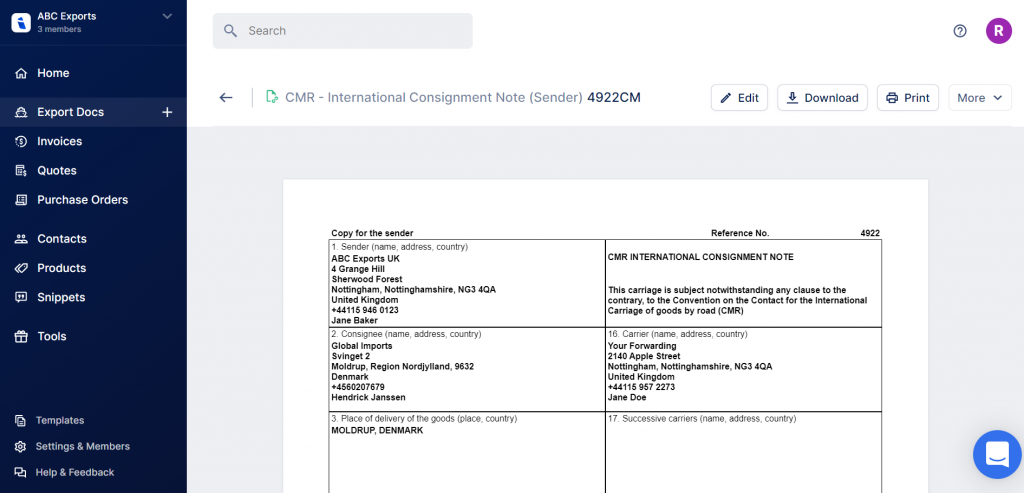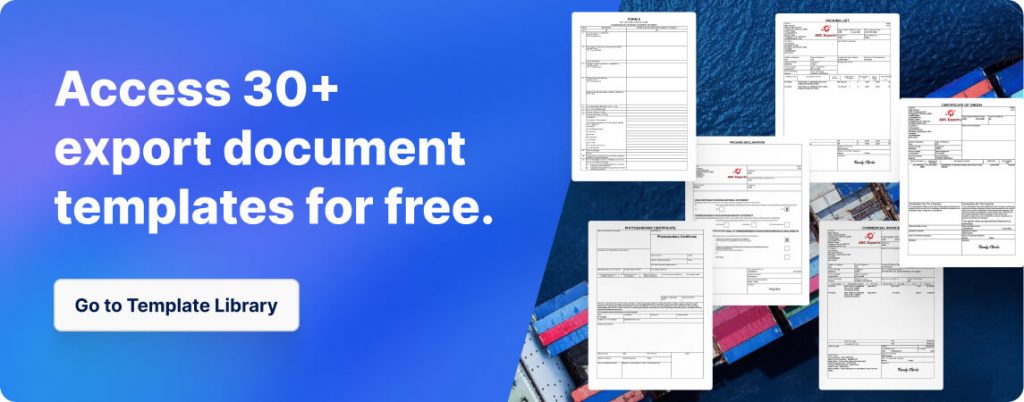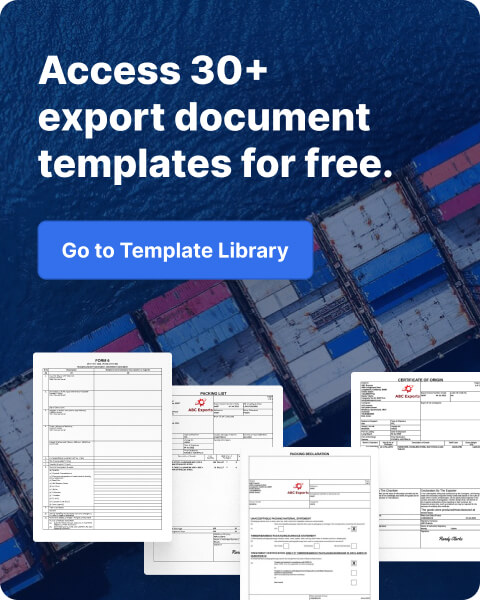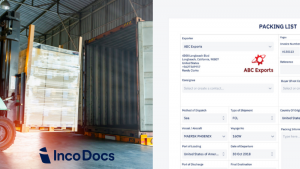Create a Consignment note or CMR Waybill used for International Road Transport.
What is a CMR International Consignment note?
A CMR note is an International Consignment note that is the standard contract of carriage of goods document that is used when transporting goods Internationally via road. The CMR note can also be known as a CMR Waybill or International Consignment Note (ICN).
The CMR Consignment note was defined under the 1956 United Nations Convention on the Contract for the International Carriage of Goods by Road, the CMR convention.
CMR stands for ‘Convention relative au contrat de transport international de marchandises par route’, which can be translated to ‘Carriage of Merchandise by Road‘.
Why are CMR Consignment notes required for the International transport of goods via road?
The CMR note contains important information agreed upon between the consignor and the carriage company or haulier. This document clearly states the responsibilities of both parties and forms a contract between the sender and the haulage company, and details the liability and transport conditions of carriage.
A CMR note is similar to a Bill of Lading, however the CMR note does not give it’s holder or carrier the rights of ownership of the goods. By documenting the responsibilities of both parties the CMR will help provide protection if the goods were to be damaged or lost during the transportation of the goods.
The carriage company must have a CRM note from the consignor to be able to commercially transport goods Internationally via road. The carriage company has the right to refuse to transport the goods if a complete CMR note document is not provided.

How to create and download a CMR Consignment note document
In the past, some shippers have messed around with creating documents in Word or Excel templates. Shippers now use IncoDocs to digitally complete and sign a CMR Consignment Note online, then download PDF copies to share with other export documentation for International shipments.
Shippers complete CMR Consignment Notes in minutes by eliminating data re-entry and clicking to pre-fill contact information into the document. Try it yourself with IncoDocs.

What information is required on a CMR Consignment note document?
It’s important that shippers or forwarders provide a completed CMR Consignment document to avoid having any issues or delays through the transport and delivery process.
A CMR document will have sections labelled 1 through to 24, as per this image and the descriptions further below:

1. Sender’s (exporter) Details
This includes basic company contact information including company name and address, phone numbers and personal contact details.
2. Consignee’s (Receiver) Details
This includes basic company contact information including company name, address, phone numbers and personal contact details.
3. Place of Delivery of the goods (place, country)
The place and country of delivery of the goods.
4. Place and date of taking over the goods (place, country, date)
The place, country and date of taking over the goods.
5. Annexed documents
Any additional documentation supplied with the shipment. It’s important to include a Commercial Invoice document, a Packing List and a Certificate of Origin (in the case that the buyer can receive preferential duty treatment if a Free Trade Agreement is in place). If the goods are Hazardous Goods or Dangerous Goods, then a Dangerous Goods Note should be supplier with the shipment.
6 through to 12. Product and Packaging Details, including:
- Marks and Numbers
- Number of Packages
- Method of Packing
- Nature of the goods
- Statistical Number
- Gross Weight (kg)
- Volume (m3)
- Class, number, Letter and ADR
13. Sender’s Instructions
Any additional instructions related to the shipment, such as Customs clearance information, insurance etc.
14. Directions as to freight payment
Confirmation if the freight has been paid, or to be paid.
15. Cash on delivery
The amount that the Consignee must pay to the carrier at the point of delivery.
16. Carrier’s Details
This includes basic company contact information including company name, address, phone numbers and personal contact details.
17. Successive Carrier’s Details (applicable when there is more than 1 carrier involved in the shipment)
This includes basic company contact information including company name, address, phone numbers and personal contact details. This section may need to be signed by the carrier upon receiving the goods.
18. Carrier’s reservations and observations
This section can be completed by the carrier. They can add any notes on any observations or issues when receiving the goods. Any information added in this section must be accepted and signed by the Sender (exporter).
19. Special agreements (if applicable)
Any additional information the is agreed upon between the Sender and Carrier of goods must be added into this section. This can include information such as contract obligations, detailed delivery information, ferry transport details, applicable jurisdictions etc.
20. To be paid by: Sender, Consignee
Amounts of each charge that will be covered by the Sender or the Consignee (receiver), with the currency stated for each. Both amounts will be totaled at the bottom ‘Total to be Paid’.
21. Established in/on
Date that the contract is established and signed
22. Signature and stamp of the sender
The signature and stamp of the sender of the goods.
23. Signature and stamp of the carrier
The signature and stamp of the carrier of the goods, and Tractor license plate and Trailer license plate details.
24. Signature and stamp of the consignee
The signature and stamp of the consignee (when the goods are received)
How many copies of the CMR Consignment Note are required?
Usually there are 4 copies of a CMR note:
- Copy for the Sender
- Copy for the Carrier
- Copy for the Receiver (which accompanies the goods through to final destination)
- Copy for administration


Exporters use IncoDocs to create Commercial Invoices, Packing Lists and other shipping documentation
Exporters use IncoDocs’ cloud shipping document software to create and manage all shipping documentation in 1 place and eliminate manual data re-entry. Users eliminate data re-entry by entering data into 1 master screen then have everything instantly sync to all shipping documents required.
Shipping documents include Commercial Invoices, Packing Lists (for FCL, LCL Air or Consolidated shipments), Verified Gross Mass Declarations (VGM), Shipper’s Letter of Instruction (SLI), Forwarding Instructions (FI), Manufacturer’s Declarations and other shipping documentation.








